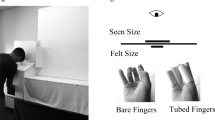Abstract
In studies on haptic rod length perception, participants conventionally report their length estimates by placing a visual landmark at a position equal to the rod’s perceived endpoint. We hypothesized that this visual aspect substantially increases the variability of the recorded length judgments. To examine this, we developed a virtual reality length judgment apparatus that provides better visual information. Participants performed a rod length perception task in both the conventional apparatus and the virtual reality apparatus. The variability of the length judgments was found to be higher in the conventional apparatus. We determined that between half and two-thirds of the variance in the conventional apparatus is haptic variance. Thus, vision accounts for between one-third and half of the variance that was previously thought to be haptic variance. Our finding implies that the virtual reality apparatus may be more suitable for studying subtle effects in haptic rod length perception.
Access this chapter
Tax calculation will be finalised at checkout
Purchases are for personal use only
Preview
Unable to display preview. Download preview PDF.
Similar content being viewed by others
References
Solomon, H.Y., Turvey, M.T.: Haptically perceiving the distances reachable with hand-held objects. J. Exp. Psychol. Hum. Percept. Perform. 14(3), 404–427 (1988)
Kingma, I., van de Langenberg, R., Beek, P.J.: Which mechanical invariants are associated with the perception of length and heaviness of a nonvisible handheld rod? testing the inertia tensor hypothesis. J. Exp. Psychol. Hum. Percept. Perform. 30(2), 346–354 (2004)
Künnapas, T.: Distance perception as a function of available cues. J. Exp. Psychol. 77(4), 523–529 (1968)
Bradshaw, M.F., Rogers, B.J.: The interaction of binocular disparity and Motion Parallax in the computation of depth. Vision Res. 36(21), 3457–3468 (1996)
Smeets, J.B.J., van den Dobbelsteen, J.J., de Grave, D.D.J., van Beers, R.J., Brenner, E.: Sensory integration does not lead to sensory calibration. Proc. Natl. Acad. Sci. USA 103(49), 18781–18786 (2006)
Debats, N.B., van de Langenberg, R.W., Kingma, I., Smeets, J.B.J., Beek, P.J.: Exploratory Movements Determine Cue Weighting in Haptic Length Perception of Handheld Rods. J. Neurophysiol. 104, 2821–2830 (2010)
Menger, R., Withagen, R.: How mechanical context and feedback jointly determine the use of mechanical variables in length perception by dynamic touch. Atten. Percept. Psychophys. 71(8), 1862–1875 (2009)
Chan, T.-C.: The situational effects on haptic perception of rod length. Percept. Psychophys. 58(7), 1110–1123 (1996)
Author information
Authors and Affiliations
Editor information
Editors and Affiliations
Rights and permissions
Copyright information
© 2012 Springer-Verlag Berlin Heidelberg
About this paper
Cite this paper
Debats, N.B., Kingma, I., Beek, P.J., Smeets, J.B.J. (2012). The Precision of “Haptic” Rod Length Perception Is Reduced by Lack of Visual Precision. In: Isokoski, P., Springare, J. (eds) Haptics: Perception, Devices, Mobility, and Communication. EuroHaptics 2012. Lecture Notes in Computer Science, vol 7283. Springer, Berlin, Heidelberg. https://doi.org/10.1007/978-3-642-31404-9_4
Download citation
DOI: https://doi.org/10.1007/978-3-642-31404-9_4
Publisher Name: Springer, Berlin, Heidelberg
Print ISBN: 978-3-642-31403-2
Online ISBN: 978-3-642-31404-9
eBook Packages: Computer ScienceComputer Science (R0)




